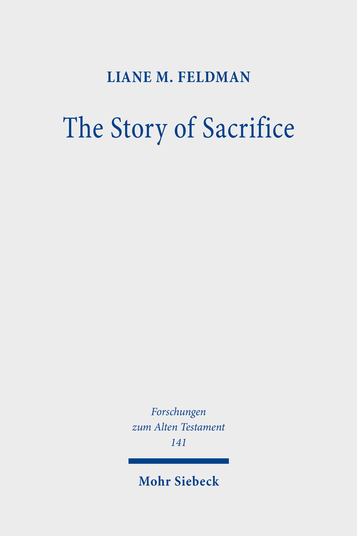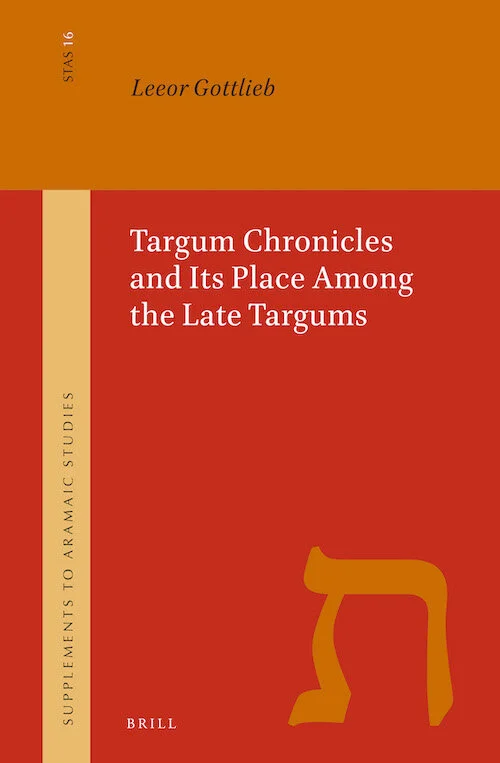While studies of the economy in Palestine during Tannaitic and Amoraic periods have a great quantity of textual evidence to draw upon, including but not limited to rabbinic sources, there is much less material available from the Second Temple period available for such an analysis. As such, Gordon’s work attempts to examine a wide range of both textual and archaeological evidence in order to flesh out our knowledge of the Jerusalem Temple economy.
Read MoreReview | The History of the Church: A New Translation
Schott’s translation requires dedication on the part of the reader who may need to use the glossary, but also renders the Greek language and rhetorical techniques Eusebius employs more visible.
Read MoreSharing Work, Requesting Feedback, and Offering Critique: A Modest Proposal
If we are to individually tailor our responses, how can we figure out what sort of feedback someone is seeking?
Read MoreBook Note | The Story of Sacrifice
In The Story of Sacrifice, Liane M. Feldman offers an innovative reading of the pentateuchal Priestly source, taking on two of the most entrenched dichotomies in biblical studies: (1) ritual vs. narrative and (2) literature vs. history.
Read MoreThe Ascension of Isaiah: Some Thoughts
Christ Pantokrator, Fresco from the Nativity of the Theotokos Church in Bitola, Macedonia (image courtesy of Wikimedia Commons).
Christ Pantokrator, Fresco from the Nativity of the Theotokos Church in Bitola, Macedonia (image courtesy of Wikimedia Commons).
Leaving behind the old redactional-stages approach (that has tempted many scholars through today), we are really forced to think about what “Jewish” and “Christian” should mean as identity or boundary-categories in the world of this text. Clearly it is too simplistic to lop off the Ascension section as “Christian” and call the Martyrdom section “Jewish,” since the Ascension participates in innumerable ways in a Jewish apocalyptic ascent framework, while the Martyrdom section is deeply enmeshed with the Ascension.
Read MoreSpecial Delivery: The Hidden Birth of Jesus in the Ascension of Isaiah 11
The emphasis on the abnormal aspects of Mary’s childbearing prompts reflection on whether the text conveys a real birth of a real man, or an appearance which circumvents the usual modes of human entry and human being in the world.
Read MoreThe Ascension of Isaiah Through the Prism of Papyrus Amherst 1
Additionally, Isaiah as a character is, I think, modeled as a Matthean Christ-figure in certain respects: both are positioned as part of a prophetic critique of ruling powers, tempted by some kind of evil entity to renounce something and gain earthly status, and killed with a wooden instrument. The charge of prophesying against Jerusalem is crucial in the trials of Jesus and Isaiah. The title ‘the Beloved’ is also emphasized uniquely in Matthew’s gospel with a citation from the Book of Isaiah (Matt 12:18).
Read MoreThe Ascension of Isaiah: A BRANE Forum
AJR is pleased to host a series of articles on new scholarship on the Ascension of Isaiah. These articles all originated as papers presented at the BRANE Collective’s Primary Text Lab III, on Wednesday, June 23, 2021.
Read MoreWhat Does the Ascension of Isaiah Do?
Detail of a miniature of the martyrdom of Isaiah, BL MS Royal 17 E VII f. 36v
Detail of a miniature of the martyrdom of Isaiah, BL MS Royal 17 E VII f. 36v
I like to think about apocalyptic rhetoric far more than I like to think about apocalypses: that is, what is a particular text doing vs. what is this text? So when I think about Ascension of Isaiah my question is: What is this particular text doing for readers and audiences?
Read MoreAn Introduction to the Ascension of Isaiah
Apocryphal Book of the Ascension of Isaiah in Ge‘ez [20th century], British Library, EAP357/1/11, https://eap.bl.uk/archive-file/EAP357-1-11
Apocryphal Book of the Ascension of Isaiah in Ge‘ez [20th century], British Library, EAP357/1/11, https://eap.bl.uk/archive-file/EAP357-1-11
Although it is often described as an apocalypse, the Ascension defies simple categorisation. As a result, it invites capacious conversation about the categories that modern scholars use to understand ancient texts and about how scholars study texts with expansive histories across historical, linguistic, and religious contexts.
Read MorePublication | The Slow Fall of Babel: Languages and Identities in Late Antique Christianity
What does it mean to be labeled a foreign language speaker in late antique Christianity? How was one’s status as a native or non-native speaker determined? Was such a person considered a heretic? A barbarian? A Christian of equal standing? A saint or a demon?
Read MoreReview | Apocalypse as Holy War: Divine Politics and Polemics in the Letters of Paul
Wasserman posits that Jewish apocalyptic works are better understood as myths about relationships in the divine realm. These writings do not share a common worldview (especially two age dualism) or theological system, but rather premises about the structure of the world.
Read MoreAJR Conversations I Texts After Terror
AJR continues its conversations series with an exchange between Rhiannon Graybill and Jill Hicks-Keeton on Graybill’s new book, Texts After Terror: Rape, Sexual Violence, and the Hebrew Bible (Oxford University Press, 2021).
Read MoreReview I The Godman and the Sea: The Empty Tomb, the Trauma of the Jews, and the Gospel of Mark
Echoing the atomsphere of Mark, Thate left his book intentionally unfinished. As a whole, The Godman and the Sea covers a wide range of scholarly debates surrounding the Markan narrative
Read MoreReview | Cicero and the Rise of Deification at Rome
By deftly combining textual analysis and historical considerations, Cole walks the readers through more than forty of Cicero’s writings (from his political orations, philosophical treatises, and personal letters) written between the late 70s and the late 40s BCE. Cole’s analysis demonstrates how Cicero introduced, experimented, and negotiated a new conceptualization of deification in Rome.
Read MorePublication | The Epistles for All Christians
How did the Gospels circulate? Is there any way to determine how they might have or what the evangelists expected for their circulation?
Read MoreBook Note | Targum Chronicles and its Place Among the Late Targums
“The demonstrably late date of Targum Chronicles – and its affinities with the Jewish Aramaic translation of some other biblical books – suggest that some Jews were interested in carrying on a tradition of translation that no longer rendered the text of the Hebrew Bible into their mother tongue.”
Read MoreBook Note I Gender in the Rhetoric of Jesus: Women in Q
Sara Parks, Gender in the Rhetoric of Jesus: Women in Q (Lanham: Lexington Books/Fortress Academic, 2019)
[Please note: the author of this review completed the index for Gender in the Rhetoric of Jesus on a freelance basis. The author did not perform any research or editing for the book.]
In this compelling monograph, Sara Parks combines two scholarly interests that have not been brought together before: studies of Q, a hypothetical source that explains the material shared by the Gospel of Matthew and Luke, and studies of the historical Jesus’ relationship to women. Parks argues that Q uses a unique literary device, which she terms “parallel gender pairs” (e.g., the Parable of the Lost Sheep and the Parable of the Lost Coin; she also refers to them as “gendered pairs”), to treat male and female listeners with a certain kind of equality. Although this literary device does not appear in any extant Hellenistic or early Jewish literature, Parks finds echoes of it in some of the texts that follow Q. Others have taken note of the gendered pairs, especially as they occur in the later gospel of Luke (e.g., Turid Seim, Alicia Batten, Kathleen Corley, Amy-Jill Levine, Luise Schottroff), but disagree about the implications of these sayings for women. The key argument of Parks is that, through these parallel gender pairs, Q intentionally delivers the same teaching to men and women, but not in a way that disrupts gendered social expectations. In this, she skillfully avoids feminist supersessionism—a tendency to claim that Jesus initiated Christianity in ways that promoted the equality of women over and against an oppressive and patriarchal Judaism.
Gender in the Rhetoric of Jesus includes seven chapters. Chapter 1 introduces the interest in the parallel gender pairs, the scholarly debates about their implications for women, and the ways that the project employs historical-critical and feminist methods. Introductory material continues into Chapter 2, where Parks outlines the issues that have been central to the study of Q, including the process by which “Q became a text” (29). Here, Parks offers key assertions about the social context of Q, including its Galilean provenance, its interest in Jesus’ teachings along with its lack of interest in his biography, and its rural, agrarian, Jewish demographic (31). This chapter may be of particular interest to those who question what Jesus might have said to and about women, but who may not be familiar with the nuances of Q scholarship.
In Chapter 3, Parks contends that there are substantial differences between the context of the parallel gender pairs in Q and the texts of the New Testament. Parks reviews and engages the scholarship about the gender pairs in the early Jesus movement, and ultimately concludes that the picture for women is complicated: “Q treats women equally in certain specific ways and not in every way” (66, emphasis original). The gender pairs do signal an intentional inclusion of women in the Jesus movement, but they do not necessarily overturn gendered divisions of labor or traditional social roles.
In Chapter 4, Parks divides the parallel gender pairs into two major categories: binary sets of parables and briefer binary phrases.
Parks offers nuance to this taxonomy, however, by differentiating three possible ways that the texts indicate gender: gender implied, gender overt, or gender overt and implied. Gender implied refers to paired sayings in which the gender of the protagonists is not indicated directly but is implied indirectly by other elements usually associated with gender, such as tasks traditionally performed by men or women. Gender overt pairs make direct references to the gender of the protagonists.
Chapter 5 asks another question: “Were There Gendered Parable Pairs before Jesus?”. According to Parks, the answer is “no.” After examining the Hebrew Bible, Apocrypha, Pseudepigrapha, and various Greek texts, Parks argues that parallel gender pairs represent a rhetorical innovation that originated with Jesus. Despite several “close calls,” these comparisons indicate that “the poetic synonymous parallelism in Hebrew literature, the double injunction in the pseudepigraphon Joseph and Aseneth that cannot be dated prior to Q, or the posited wordplay of the scribes, do not provide convincing origins for Q’s gendered pairing” (122).
Chapter 6 moves forward in time by examining later texts such as the undisputed letters of Paul, the canonical gospels, the book of Acts, and texts from beyond the Jesus movement including De Vita Contemplativa, Joseph and Aseneth, and That Women Too Should Study Philosophy. Although the gender pairs represent a rhetorical innovation made by Jesus, Parks’ comparative readings of these texts demonstrate that the pairs did not appear ex nihilo; other texts from within the 1st century Jewish and Roman context are discussing and debating ways that women might be considered equal.
The final chapter notes that Gender in the Rhetoric of Jesus is the first book-length work in English that studies the parallel gender pairs. Parks argues that this innovative rhetorical technique “should play a much greater role in our investigations into where women and gender fit” within the early Jesus movement (151). Several of these pairs have been attributed to Luke based on the view that this gospel was more inclusive of women, but Parks’ work shows that some of the pairs more likely originated in Q, raising important questions about why the gendered pairs were diminished as Christianity persisted.
Throughout this book, Parks offers a nuanced analysis of the parallel gender pairs in Q. By demonstrating the uniqueness of these gender paired sayings, Parks draws thoughtful conclusions about their function within the broader context of Q. The pairs demonstrate that men and women are equal with regard to their spiritual inclusion and eschatological agency, even as socially gendered roles are maintained. Parks’ work clarifies long-standing questions about what these sayings might mean for women in the Jesus movement, and provides an important contribution to the study of Q and the study of Jesus’ treatment of women.
Hilary Floyd is a PhD student at Drew University in the area of Bible and Cultures. Her work focuses on the New Testament and early Christianity, especially the parables and the relationship between economic context and interpretation.
Dissertation Spotlight | Representing the Destruction of Jerusalem: Literary Artistry and the Shaping of Memory in 2 Kings 25, Lamentations, and Ezekiel
“I contend, however, that the impetus to reconstruct a historical account of ‘what really happened’ has significantly undertheorized the differing ways in which biblical texts both recount and shape the very idea of destruction of Jerusalem.”
Read MoreRetrospective on the Intersection of Translation and Commentary in Ancient Judaism and Its Greco-Roman Context | Steven Fraade
“From my first book to my most recent, comparison (and its pitfalls), both within Judaism and without, has been a constant preoccupation as I continued to focus on texts of legal interpretation, and to struggle with how best to translate the rabbinic texts upon which I was commenting and to what extent either should inform or presume the other.”
Read More
![Lucio Fontana, Madonna (1956) [Image courtesy of Flickr]](https://images.squarespace-cdn.com/content/v1/5449167fe4b078c86b41f810/1622988343090-4AM7PUQWZC81Y45Z8TT0/17329001992_c0c2f0cdba_c.jpg)







![Wassily Kandinsky, Improvisation No. 30 (Cannons) (1913) Art Institute of Chicago [Wikimedia]](https://images.squarespace-cdn.com/content/v1/5449167fe4b078c86b41f810/1609962640997-3MBGSGUU9XHIBF1Q3OJZ/601px-Vasily_Kandinsky%2C_Improvisation_No._30_%28Cannons%29%2C_1913%2C_1931.511%2C_Art_Institute_of_Chicago.jpg)



![Guercino, Saint Paul (ca. 1591-1666 CE) [Wikimedia]](https://images.squarespace-cdn.com/content/v1/5449167fe4b078c86b41f810/1625346930471-3KOGD69T3Y7CC1IPPOE9/Saint_Paul_MET_DP810223.jpg)




